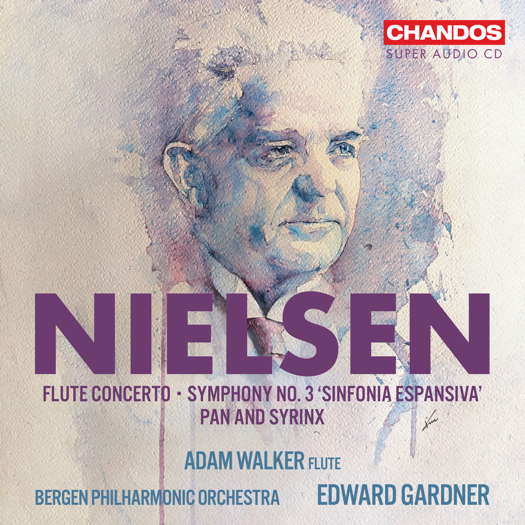 SPONSORED: Ensemble. Melting Rhapsody - Malcolm Miller enjoys Jack Liebeck and Danny Driver's 'Hebrew Melody' recital, plus a recital by David Aaron Carpenter.
SPONSORED: Ensemble. Melting Rhapsody - Malcolm Miller enjoys Jack Liebeck and Danny Driver's 'Hebrew Melody' recital, plus a recital by David Aaron Carpenter.
All sponsored features >>

Expansion of Life
GERALD FENECH listens to three works by Carl Nielsen
'... performances of the utmost precision and potent perceptiveness ...'
Carl Nielsen is undoubtedly Denmark's greatest musical son and he excelled in every genre he embraced, but his reputation rests mainly on his symphonic work, particularly his six great symphonies, which are regarded as beacons in twentieth century symphonic literature. What is so attractive about this CD in hand is the fact that it covers three of Nielsen's compositional gifts: the concerto, the symphony and the symphonic poem.
Nielsen's Concerto for Flute and Orchestra was written in 1926 for the flutist Holger Gilbert Jespersen, but the idea to write such a piece was sowed in 1921 when the composer heard the Copenhagen Wind Quintet rehearsing music by Mozart and was struck by the group's tonal beauty and musicianship. That same year he not only composed expressly for this ensemble, but also promised its five members that he would write a concerto for each member of the quintet. He started with the flautist Holger Gilbert Jespersen but, as a result of Nielsen's poor health, he was only able to complete one more concerto before his death, the Clarinet Concerto for the group's clarinettist Aage Oxenvad, which he completed in 1928.
Nielsen began work on the concerto while travelling in Germany and Italy in August 1926, intending it to be performed in Paris at a concert devoted to four of his works on 21 October. Unfortunately, as a result of prolonged stomach complaints, he did not complete the work in time and had to introduce a temporary ending for its Paris premiere. The concerto was favourably received at its Paris premiere on 21 October 1926, and the Comoedia critic Paul Le Flem wrote:
The Flute Concerto, outstandingly performed by M Holger Gilbert Jespersen, is the most recent work by Carl Nielsen. It has piquancy, drive and does not lack humour.
It was reported that both Ravel and Honegger were in the audience, the latter being recorded as saying:
The Conservatory Orchestra played great and the flute concerto was performed in a masterly manner and with a delicate tone. There was a standing ovation and the soloist was called in several times.
The first complete version was performed at the Music Society in Copenhagen on 25 January 1927 and has become part of the international Nielsen repertoire.
Listen — Nielsen: Allegretto, un poco (Flute Concerto)
(CHSA 5312 track 2, 0:00-0:58) ℗ 2024 Chandos Records Ltd :
Symphony No 3 (Sinfonia Espansiva), Op 27, is a sweeping score and features strong pulsating rhythms, folk-influenced melodies for strings and a deep sense of yearning. The composer's most wistful and idyllic moments are in the second slow movement, where Nielsen introduces the wordless voices of a soprano and baritone to create an atmosphere of belonging that has an aura of magic and mystery written all over it.
Listen — Nielsen: Andante pastorale (Sinfonia Espansiva)
(CHSA 5312 track 5, 8:02-9:01) ℗ 2024 Chandos Records Ltd :
The rustic scherzo movement has some enjoyable pungent passages for winds, while the finale, in the fitting words of the composer, is a 'hymn to work and the healthy activity of living'.
Listen — Nielsen: Finale. Allegro (Sinfonia Espansiva)
(CHSA 5312 track 7, 0:01-0:58) ℗ 2024 Chandos Records Ltd :
Maybe you are asking why this symphony was dubbed 'Espansiva' by the composer? To start with, this sub-title was there from the start, something which created some confusion about its meaning. Indeed, No 3 was no more expansive than the second, nor did it require an expanded orchestra. According to composer Robert Simpson, Nielsen's 'espansiva' terminology referred to 'the outward growth of the mind's scope and the expansion of life that comes from it'.
After the Copenhagen premiere on 28 February 1912, a concert which also included the composer's violin concerto, this truly sunny work gave Nielsen his first real international credibility, and it was soon performed in Holland, Germany, Sweden and Finland with outstanding success. The 'Espansiva' was indeed the launching pad from which Nielsen catapulted to lasting fame.
The Symphonic Poem Pan and Syrinx, Op 49, is based on the ancient legend which tells how the amorous god Pan invented the pan flute when following the nymph Syrinx, who is transformed into hollow water reeds that made a haunting sound when the god's frustrated breath blew across them. But then Pan cut the reeds to fashion the first set of pan pipes, which were thenceforth known as 'syrinx'.
Obviously, the piece has major parts for woodwind solos, and Nielsen wrote it when he was at the height of his powers, shortly after the Fourth Symphony in 1917. Premiered on 11 February 1918 in Copenhagen, this highly descriptive work was well received and remains to this day one of Nielsen's most popular pieces.
Listen — Nielsen: Pan og Syrinx
(CHSA 5312 track 1, 7:32-8:24) ℗ 2024 Chandos Records Ltd :
Edward Gardner and his Bergen Philharmonic Orchestra players tackle these superb scores with effortless aplomb, and their enormous dedication to the Nielsen cause is evident in performances of the utmost precision and potent perceptiveness, where all of Nielsen's inventive writing is brought out with unblemished clarity. Another wonderful addition to the Nielsen/Gardner cycle which should not be missed.
Copyright © 5 May 2024
Gerald Fenech,
Gzira, Malta




